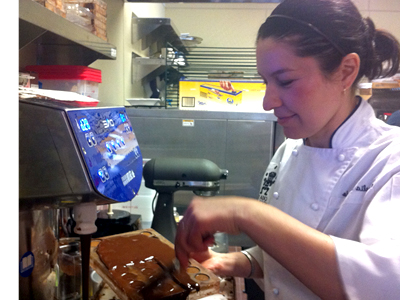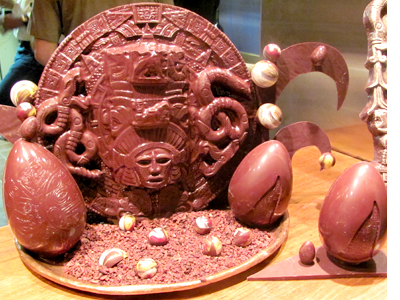
The story of chocolate begins in Latin America, and two women in Berkeley are eager to share it. Last month, Amelia Gonzalez and Arcelia Gallardo, opened Casa De Chocolates, a chocolate and pastry store honoring the flavors, ingredients and designs native to Latin America.
Gallardo, the chocolatier, began her journey with chocolate following her first bite of See’s Candies. “Growing up in Los Angeles, See’s Candies was the ultimate chocolate,” she said. “But even so, I never liked the fillings.”
Gallardo described the mysterious creamy fillings as tasting drastically different from the flavors common in the Latino neighborhood where she grew up. Those familiar flavors were still absent, even as Gallardo moved on to tasting different brands. “So, I started reading about it and studying, and I learned that chocolate was actually native to Mexico and to South America, and I thought, this is really interesting, I wonder what else I could learn about chocolate?” she said.  A graduate of Le Cordon Bleu culinary school in Pasadena, Gallardo’s quest to follow the path of chocolate took her from Mexico to Spain, France, Italy, Belgium and Switzerland. In each country she trained under chefs and chocolatiers, learning the traditions and techniques indigenous to each place, and envisioning a craft of her own. After graduating from UC Berkeley and while working at Le Cordon Bleu, Gallardo started Casa de Chocolates. Up until February, she was using a commercial kitchen to cater private parties and sell at local events. Now, Gallardo will be handcrafting her treats in her own kitchen, while her partner manages the infrastructure aspects of the business. Gonzalez, also originally from Los Angeles, comes from a career in public media, with over twenty years at KPFA-FM in Berkeley. She’s lived in Lima, Peru, and Oaxaca, Mexico, a state where chocolate plays an essential role in the region’s most treasured recipes.
A graduate of Le Cordon Bleu culinary school in Pasadena, Gallardo’s quest to follow the path of chocolate took her from Mexico to Spain, France, Italy, Belgium and Switzerland. In each country she trained under chefs and chocolatiers, learning the traditions and techniques indigenous to each place, and envisioning a craft of her own. After graduating from UC Berkeley and while working at Le Cordon Bleu, Gallardo started Casa de Chocolates. Up until February, she was using a commercial kitchen to cater private parties and sell at local events. Now, Gallardo will be handcrafting her treats in her own kitchen, while her partner manages the infrastructure aspects of the business. Gonzalez, also originally from Los Angeles, comes from a career in public media, with over twenty years at KPFA-FM in Berkeley. She’s lived in Lima, Peru, and Oaxaca, Mexico, a state where chocolate plays an essential role in the region’s most treasured recipes.
Together, the two Mexican American women have created a place where Latin America meets modern world European chocolate. Inside the store, a case displays bonbons with fillings like Mexican tamarindo, Belizean vanilla and Guatemalan espresso. A white chocolate Virgin de Guadalupe glows from on top of a shelf. Coconut macaroons are offered, gluten free and drizzled with dark chocolate. Molinillos (whisks for making Mexican hot chocolate) sit in black ceramic vases from Oaxaca against the warm golden walls. Chocolate Aztec and Mayan calendars weighing up to three pounds sit on the counters, paying homage to the ancient civilizations that discovered cacao. Gallardo also wants to honor the contemporary Latin American communities growing cacao, by using only fair and direct trade chocolate. She plans to source cacao directly from small farms in Belize, Mexico and South America. “All of these cacao growing communities are really poor, so there are a lot of tiers of what we want to do with the company: We want to make good chocolate, we want to educate people about chocolate, but we also want to help the cacao growers, help the farmers, and help their communities,” she said. “Maybe we’ll also teach the women of each community how to do sustainable crafts that we can sell in the store. We want our relationship to support something that will revive the community.” As for the rest of Casa De Chocolate’s ingredients, they’re organic and local when possible.
Gallardo also wants to honor the contemporary Latin American communities growing cacao, by using only fair and direct trade chocolate. She plans to source cacao directly from small farms in Belize, Mexico and South America. “All of these cacao growing communities are really poor, so there are a lot of tiers of what we want to do with the company: We want to make good chocolate, we want to educate people about chocolate, but we also want to help the cacao growers, help the farmers, and help their communities,” she said. “Maybe we’ll also teach the women of each community how to do sustainable crafts that we can sell in the store. We want our relationship to support something that will revive the community.” As for the rest of Casa De Chocolate’s ingredients, they’re organic and local when possible.
As the business grows, Gallardo hopes to establish a non-profit that will empower at-risk youth to work with chocolate and build confidence, inside and outside of the kitchen. She even talks about opening a chocolate museum. “I want to teach people about what’s native to Latin America, I want it to be an educational experience,” she said. “Yes, it’s good and it’s pretty, but I also want people to walk away with something they didn’t know before.”
